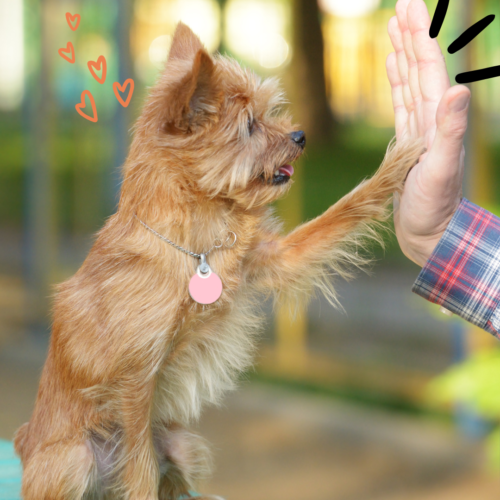Look, I get it – seeing a dog in a muzzle might make your heart sink a little. Trust me, I felt the same way before I became a dog trainer! But here’s the tea: muzzles aren’t the scary torture devices that TikTok might have you believing they are.
Did you know that a large number of dog owners have totally wrong ideas about muzzle use? Oof. As someone who’s studied and trained my three doggies with the use of them, I’m here to spill all the facts about muzzles – the good, the bad, and yes, even the cute ones with little designs on them! 💁♀️
**To clarify, the links on this article are not affiliate links. They’re suggested products my fellow doggy parents and I have used to raise our pups the best way we can!**
Let’s Talk Muzzle Types (Because Not All Muzzles Are Created Equal)
First things first – forget those fabric muzzles you see at PetSmart. The real MVP is the basket muzzle, which looks kind of like a cute little dog face mask (very 2020, am I right?). Here’s why they’re actually amazing:
- Your dog can still drink water, pant, and even take treats! (Yes, really!)
- They’re super comfortable when fitted properly (think sports bra, but for your dog’s face)
- They come in different colors and styles (because who says safety can’t be cute?)
The logos below are links to three great muzzle brands for your pup! Click on them to see what I’m talking about 🐾❤️
Those tight fabric muzzles? They’re also called soft muzzles. Those may look nicer than the basket, but they’re like the skinny jeans of the muzzle world – okay for quick vet visits, but not for hanging out in. They restrict breathing and can stress your pup out.
When Muzzles Are Actually a Total Game-Changer
Let me share a quick story. Whenever my brother and I brought Riley to the vet, she would have major anxiety. Like, major major. She would get tense and cry when she simply saw the vet’s office building. Using a properly fitted basket muzzle literally changed our whole vet experience when we got her to feel safe using them. Riley is one of those dogs who calm down when she has her muzzle on. Here’s when muzzles can be your BFF:
- Vet visits (especially if your dog is giving those “please don’t touch me” vibes)
- Grooming sessions (because nobody wants to accidentally bite their stylist)
- When working through reactive behaviors (think of it as training wheels for dogs)
- Emergency situations (like if your pup is injured and scared)
The Not-So-Great Side of Muzzles
Real talk – muzzles aren’t perfect. Like any tool (looking at you, heated eyelash curler), they can cause problems if used wrong. Here’s what to watch out for:
- Using them for too long (they’re not an all-day accessory)
- Improper fitting (too tight or too loose = big no-no)
- Using them as a quick fix for behavioral issues (sorry, but your furry friend needs actual training)
- Making your dog feel stressed or anxious (defeats the whole purpose, right?)
How to Make Your Dog Actually *Love* Their Muzzle
No cap – you can totally train your dog to love their muzzle! Here’s Riley’s method:
- Start by just letting them sniff the muzzle. Give them a treat. Keep repeating until they’re at ease.
- Progress by putting treats inside the muzzle. Let them figure out it’s basically a treat dispenser. Keep repeating until they’re at ease.
- Put the muzzle on their nose unbuckled. Give them a treat. Keep repeating!
- Buckle the muzzle. Give them a treat. Keep repeating!
- Slowly increase wearing time, always keeping it positive and rewarding. Keep repeating!
- Practice in different situations, but keep it short and sweet at first.
Remember that this is going to take time! There’s going to be a lot of repetition for them to be properly trained, so treat each step with care and patience.
Pro tip: Use high-value treats for this. We’re talking chicken, cheese, or whatever makes your pup literally can’t even. 🧀
Alternatives to Consider
Sometimes a muzzle isn’t the answer. Here are some other options to consider:
- Working with a force-free trainer (seriously worth the investment)
- Managing your dog’s environment (sometimes it’s about avoiding triggers)
- Positive reinforcement training (because treats > force, always)
- Anxiety wraps or calming aids (if stress is the main issue)
The logos below are links to some of the best anxiety wraps for your pup! 🐾❤️
The Bottom Line
Here’s the thing – muzzles are kind of like face masks during the pandemic. Nobody really wants to wear them, but sometimes they’re the safest choice for everyone involved. The key is using them properly, training gradually, and always, always prioritizing your dog’s comfort.
If you’re considering a muzzle for your fur baby, remember:
- It doesn’t make you a bad parent
- It doesn’t mean your dog is bad
- It means you’re being responsible and proactive about everyone’s safety
Want to learn more about muzzle training? Drop a comment below, or better yet, consult with a certified force-free trainer in your area. Your pup (and their future vet) will thank you! ✨
—
*Note: Always consult with a professional trainer or veterinary behaviorist before starting muzzle training. Every dog is unique, and what works for one might not work for another.*









Leave a Reply